 Jordan’s Minister of Water and Irrigation and Agriculture, Hazim Al Naser, disclosed that the controversial Red-Dead Water Conveyor project may now be shelved in favor of a series of smaller schemes to provide the kingdom with drinking water.
Jordan’s Minister of Water and Irrigation and Agriculture, Hazim Al Naser, disclosed that the controversial Red-Dead Water Conveyor project may now be shelved in favor of a series of smaller schemes to provide the kingdom with drinking water.
His statements mark the first time that a ranking official questioned the project’s viability. Al Naser spoke at a recent presentation of the final Environmental Impact Assessment (EIA) for the project, where the World Bank and the Ministry of Environment advised stakeholders of the plans more dubious aspects.
The presentation was organized by EDAMA, a Jordanian business association that seeks innovative solutions for the kingdom’s energy and water needs, with an emphasis on environmental assessment. EDAMA is an Arabic word meaning “sustainability”.
Green Prophet’s reported extensively on the Red-to-Dead project which would pump 1.2 billion cubic meters of water from the Red Sea through a series of energy-intensive desalination plants to create usable fresh water. The desalinated water would be made available for domestic use and the toxic brine discharged to the Dead Sea.
This was spun as a good news story for the smaller sea, promising to restore it to former levels, or at a minimum, halt further evaporation. Some say it’s a political boondoggle to underpin efforts to promote nuclear power (the project requires 800 megawatts of electricity for pumping, desalination, and facility operation).
The EIA and related feasibility study recommend proceeding with the project the green light, but the findings illustrate that the concept is flawed.
The Dead Sea is the world’s saltiest lake at the lowest altitude with its surface about 420 meters below sea level. Levels have dropped by 27 meters since the 1960s due to climate change, increased evaporation, and significantly reduced incoming flows from its tributaries, the Jordan and Yarmouk rivers.
Chemical interaction between Red Sea sulphate and Dead Sea calcium will create a layer of white gypsum on the Dead Sea surface, destroying the natural beauty that currently attracts tourists. The blended waters will encourage algae growth, causing critical impact to the Dead Sea mineral industry.
Seawater modeling indicates a maximum safe discharge of 350 million cubic meters of desalination brine into the Dead Sea annually: any additional discharge will be environmentally damaging. This discharge volume is half of what was originally envisaged, as restoration of the Dead Sea to its mid-20th Century condition would require adding 700 million cubic meters annually.
The project also comes with a $10 billion price tag that’s out of reach for the cash-strapped kingdom. The financial feasibility study assumed that 80% of project costs would be provided by loans and donors, which will be difficult to attract given global austerity.
Minister Al Naser proposed another solution, starting with a smaller scale project to desalinate Red Sea water to produce 85 million cubic meters (MCM) of freshwater with 100 MCM of brine to go into the Dead Sea. That freshwater will be provided to Israel (50 MCM) and Palestine (35 MCM), with Jordan receiving an equal amount from Israel from sources in the northern Jordan valley.
The Red-Dead project was first conceived in 2005 and was expected to take 20 years to complete. More likely it will take 20 years to determine whether or not to start.
Image of Red to Dead project by David Shankbone



